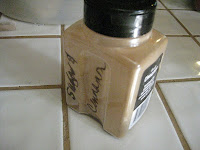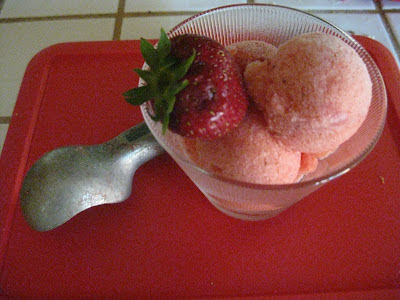Our weekend weather forecast is for some sweltering heat, perfect for some frozen desserts. With the stores featuring a wide variety of fresh fruits, this is a great time to try some easy homemade sherbets and ices, without the long list of unpronounceable ingredients and not as pricey as so many of the "all natural" choices in the freezer section.
Though it may seem strange to most people, I have never cared for ice cream. However, I was introduced to home made sherbets and sorbets when living in the desert southwest and found much to like in these intense but light deserts. There may be purists who will debate whether these are sherbets, sorbets, or fruit ices; I just call them delightful and will let you decide on the accuracy of my terminology.
*
The recipes that follow do not require an ice cream freezer (something I have never owned) but you will need a food processor to develop the best texture. If you don't own one, consider making this your next kitchen purchase--mine seemed like an extravagance when I bought it, but it has been busy making sherbet and bread dough and soups and all manner of other things for decades, still going strong and probably ready for many more years of service. A blender may also be used, though you may have to process the sherbet in batches for best results.
Unflavored Gelatin
Why, you may ask, do I have to have the unflavored gelatin and why only half a package?
Many older recipes for homemade sherbets and sorbets include beaten egg whites, and you may also find some recipes that call for marshmallow creme--which is in essence a sweetened and flavored unflavored gelatin! The reason for any of these ingredients is the protein they contribute to reducing the size of ice crystals in the final mix. The egg whites are probably the most economical, but they are never cooked so should probably be avoided--unless you have your own backyard chickens with confidence the eggs are "germ-free."
As for the half packet--I have scaled the recipes I use to the size that best fits my full-sized processor, and a full package is definitely not needed. Just roll down the package on the remaining gelatin and put in a small jar or plastic storage container. (My guess is that, once you discover how easy and delicious these sherbets are, that second half of the package will be used in another batch very soon.)
Now, to a couple of recipes, with more to come as summer proceeds.
This week I have beautiful strawberries, mangoes, blueberries, and even a watermelon and pineapple that were all purchased at bargain prices, ready for a rainbow of sherbets. These will keep for several weeks in the freezer--if you and your family can keep from eating them for that long.
Strawberry Non-Dairy Sherbet
1 teaspoon unflavored gelatin ( one half package)
1 1/2 cups cold water
3/4 cup sugar
1/4 cup lemon juice (ReaLemon type jarred lemon juice is fine here)
1 1/2 to 2 cups crushed strawberries--about 8 ounces
1. Combine the gelatin, water and sugar in a large microwave safe bowl (or saucepan if preparing on the stove top). Stir well and allow to stand for about 5 to 10 minutes.
2. Heat in microwave for 3 to 4 minutes, until the mixture comes to a rolling boil and the sugar and gelatin are completely dissolved. (If cooking on the stovetop, this may take 10 minutes or so). Remove from microwave and allow to cool until lukewarm.
3. Stir in the lemon juice and berries, place in a shallow container, cover, and place in freezer.
4. Freeze until just mushy. Break into chunks and place in processor bowl or blender. Process, using a pulse motion, until the mixture is light and creamy.
HINTS:
Do not process so long that the mixture thaws to a liquid. This can result is losing the airy creaminess and. If it does start to liquify, not to worry though. Just refreeze and process again.
If you manage to pass the "mushy" stage, no worry. Just take the mixture from the freezer and let thaw a few minutes. Use a table knife to gently break into pieces about the size of ice cubes.

(This is how it looks before beating, as the block is being broken into smaller pieces.)

(And this is what processing does to the appearance. Note its creamy consistency, very similar to ice cream or purchased sherbet.)
5. Return to the freezer. For an even smoother texture, you may want to allow the sherbet to refreeze and then process again. Store tightly covered in the freezer.
OPTIONAL STEP: If you like, cut a few more strawberries in tiny pieces and stir into the beaten sherbet just before returning to the freezer.
6. To serve, remove the sherbet from the freezer about 5 to 15 minutes ahead of time.
Variations:
This basic recipe will work for just about any soft fruit you may have--blueberries, raspberries, peaches, apricots, mangoes, plums, or any combination of these. Canned or fresh pineapple may be added; just be sure to cut in fine pieces or process lightly before freezing for best results. Fruit frozen without sugar may be used as well as fresh.
The sugar can be reduced or increased depending on the sweetness of the fruit being used.
For a slightly creamier, dairy version, add 1/2 c dry milk powder to the water, sugar and gelatin in step 1. This is more likely to foam as it heats, so be sure the container you are using is large enough.
UPDATE 6/19:
Instead of using dry milk powder for the creamier (sherbet) version, you can use "regular" milk. This would change slightly how you make the sherbet.
1 teaspoon unflavored gelatin ( one half package)
1/2 cup cold water
1 cup milk--whole milk will be the creamiest but skim or 2% will also do
3/4 cup sugar
1/4 cup lemon juice (ReaLemon type jarred lemon juice is fine here)
1 1/2 to 2 cups crushed strawberries--about 8 ounces
Combine the gelatin and water in a bowl or saucepan as above, and allow to stand 10 to 15 minutes. Then add the milk and sugar, stir, and continue with recipe as above. You will need to stir the mixture often if on the stovetop and will need to use a very large bowl in the microwave because this will foam up more than the non-dairy version.
Popsicles
Follow the recipe above through step 2. Turn the mixture into the processor (or blender) and process until smooth. Pour into either popsicle molds or two ounce paper/plastic cups. You can insert popsicle sticks into the cups at this point but they will be more centered if you wait until the mixture has just begun to freeze to add the sticks.
*If you really want some nomenclature clarification, here is the Barron's Food Lover's Companion definition for
sherbet:
[SHER-biht] The origins of sherbet can be traced to a popular Middle Eastern drink (charbet) made of sweetened fruit juice and water. Today the term sherbet
commonly refers to a frozen mixture of sweetened fruit juice (or other
liquid such as wine) and water. It can also contain milk, egg whites
and/or gelatin. Sherbet is lighter than ice cream but richer than an ice. See also sorbet.
One more, quite different recipe, this one adapted from a very old cookbook where it was labeled One Two Three Sherbet. Since I modified the proportions a bit, I re-christened it Tutti-Frutti Sherbet and often made this before the fruits of summer were readily available.

Tutti-Frutti Sherbet
2 cups cold water
1 cup sugar
1 tablespoon grated lemon rind, orange rind, or a mixture of the two
1 package unflavored gelatin
2/3 cup orange juice (best if freshly squeezed, but juice from concentrate can be used)
1/2 cup lemon juice
1 cup mashed ripe banana
1. Combine the water, sugar, citrus rinds, and gelatin. Stir well and let sit about 5 to 10 minutes. Bring to a boil and allow to simmer about 5 minutes on the stove top, or bring just to a boil (about 3 to 4 minutes) in the microwave.
2. Remove from heat and allow to cool to barely lukewarm. Stir in the juices and banana and freeze in a shallow pan until just frozen.
3. Process until smooth and return to freezer. If desired, may be processed a second time to incorporate more air and make an even creamier texture.
(This also can be made into popsicles, again processing the mixture
before putting into the popsicle molds.)











